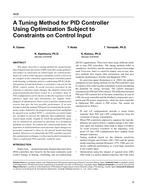
4638 — A Tuning Method for PID Controller Using Optimization Subject to Constraints on Control Input
- Comments Off on 4638 — A Tuning Method for PID Controller Using Optimization Subject to Constraints on Control Input
- ASHRAE
This paper describes a tuning method for proportional-plus-integral-plus-derivative (PID) controller using optimization subject to constraints on control input. Its control performance for a first-order lag plus a deadtime system is shown as an example of the commonly approximated controlled plants in the heating, ventilating, and air-conditioning (HVAC) fields. Attenuation of load disturbance is of primary concern for the HVAC control system. To avoid excessive overshoot in the response to reference input changes, the integral control with proportional-plus-derivative action in a secondary loop (I-PD) configuration can be chosen so that the responses to both reference input and load disturbance are slightly better damped. In optimization, there is also a need for sophisticated criteria that give the best possible performance. If we now attempt to find the optimal PID gains by minimizing the performance index, defined by the integral of squared time multiplied by squared error (called“ISTEâ€Â), constraints on control input are included to prevent the difficulty that indefinitely large control input results. Graphs by which the optimal PID gains can be obtained are presented as functions of a normalized deadtime of a plant. To evaluate the control performance, the responses to load disturbance and reference input changes are presented compared to those by the partial model matching method. Moreover, it is found that the PID controller tuned by this optimization technique is robust and useful in simulations where a traditional PID controller would be used.
Units: Dual
Citation: ASHRAE Transactions, vol. 109, pt. 2
Product Details
- Published:
- 2003
- Number of Pages:
- 10
- File Size:
- 1 file , 310 KB
- Product Code(s):
- D-20908

